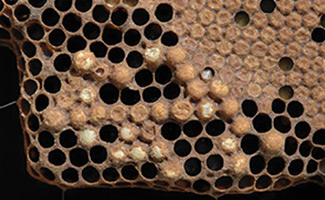
One day early in my career I was lecturing a beekeeping group in London on the topic of Varroa mite IPM. I had just covered the so-called “drone brood trapping” method. The beekeeper inserts a comb of drone cells, lets the bees fill it up with drone brood, and after it’s capped removes the comb and freezes it, then returns it to the bees so they can eat the dead brood and recover some of their nutrient investment. Because mites significantly prefer and enter drone brood cells, this manipulation also freezes and kills a substantial fraction of the mite population.
Whereupon a gentleman raised his hand and stood up in the middle of the room to address a question. He was grandfatherly, lean, statuesque, and tweedy.
“But won’t that upset the natural balance of drones the colony needs for its homeostasis?” he asked crisply.
The assembly turned their eyes back on me, in unison, with expectant looks. But I was a bit flummoxed. I had never heard anything about drones being necessary for a colony’s homeostasis. But I was also young, and perhaps a bit cocky – and a devious rejoinder entered my head. I instantly acted on it.
“Sir,” I said, “How much sperm do you need?”
The room fell silent and his eyes widened.
I love the Brits for many reasons, not least of which is their reputation – well-earned for the most part – for social grace and decorum under pressure. This gentleman was no exception. He stayed standing straight as a rail, unmoved, except for his twitching jaw. The room was deathly quiet, and a feeling was creeping over me that I may have stepped over some line.
“I don’t quite,” he said through tight lips, “Get your point.”
At which point I rather clumsily picked up on the idea, familiar to readers of this column, of the superorganism, and that drones can be metaphorically considered the sperm of the organism. And if drones are functionally the sperm of the superorganism, I rambled, then the question of sperm being necessary to the organism’s homeostasis is rather moot. After all, I argued, unless one is part of a couple wishing to conceive a child, then the number of one’s sperm doesn’t really matter a whole lot.
Groping for sympathizers in that quiet room, I concluded, “All us guys here can pretty much live normal lives regardless of our sperm count.”
Whether I gained any sympathizers that day I’ll never know, but I have often thought about that exchange over the years, wondering about the veracity of my metaphor and using it in other contexts to talk about the superorganism. Whether drones are indeed necessary, or even contribute at all, to the social network, or “homeostasis” of the colonies they belong to is still an open question, although there are tantalizing hints the answer is in the affirmative.
Moreover, my assertion that “sperm count doesn’t matter” itself deserves critique, especially in the context of a superorganism. Metaphors are after all only good to a point. The question really does boil down to, How many drones are “enough?” and being that drones are 50% of the players in the reproduction game, it makes sense that natural selection would have something to say on the matter.
The question is usually discussed by evolutionary biologists in terms of “sex ratio” or “sexual investment,” and as early as 1930, Fisher established that parents should favor a 1:1 investment in females : males across a population.1 For us “normal” diploid humans, this makes intuitive sense, given that each of us passes along 50% of our genes whether we produce a son or a daughter. It makes sense for a queen honey bee too, as she passes along 50% of her genes with every egg she lays – whether that egg becomes a male or the next queen. However, long-term readers of this column will know that the haplo-diploid genetic plan of honey bees plus their colonial structure make for some very irregular (from a human perspective) relatedness situations.
To begin, not all the members of a colony may agree on that tidy 1:1 sex ratio. The queen should, for reasons stated above, but what about the workers? – the ones who tend the brood, forage for food, defend the nest, and therefore have at least as much influence as the queen on determining the sex ratio the colony produces. Back in March 2015 I talked about how honey bee males have only half the chromosomes of females (16 instead of 32). One outcome of this is that two workers who share one father do have not 50% of their genes in common (like “normal” diploid siblings), but 75% of their genes in common. Another outcome is that any worker shares only 25% of genes in common with her brother – a male offspring of her mother. It was Trivers and Hare who in 1976 pointed out that these so-called “relatedness asymmetries” mean that whereas a queen is predicted to prefer a 1:1 female : male progeny ratio, the workers are predicted to prefer a 3:1 ratio, biased in favor of their full sisters over their brothers.2 I can imagine my older sister harboring similar sentiments while she and I were growing up.
So, genetically speaking, the stage is set for reproductive conflict between the queen and her workers. However, evolution has tended to tone down these potential troubles, and in the case of the honey bee perhaps the most important moderating force is the queen’s habit of multiple mating. As I talked about in April 2016, the queen mates with many males, storing their sperm in her spermatheca and thereafter producing workers of mixed paternity, resulting in high within-colony genetic diversity. The relatedness asymmetries discussed above would lead us to predict that nurse workers give preferential treatment to their own full sisters. However, this does not seem to happen. The bulk of evidence indicates that …


